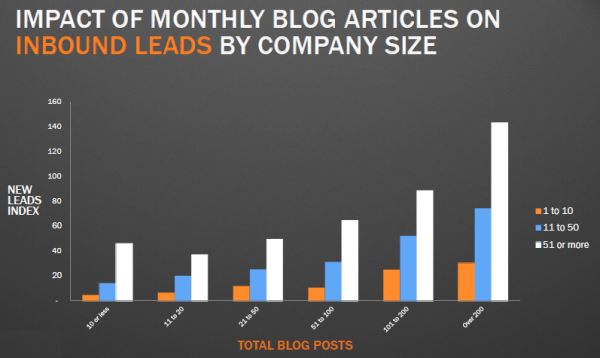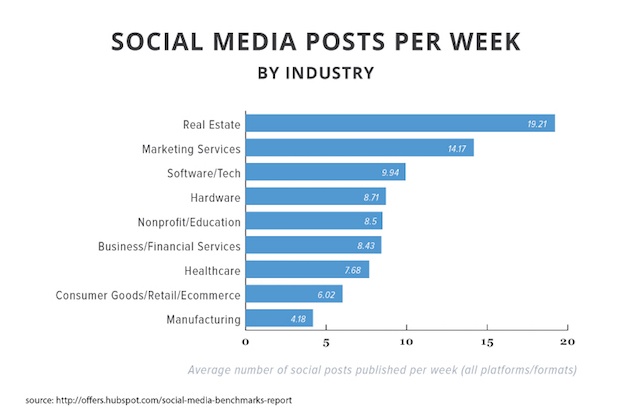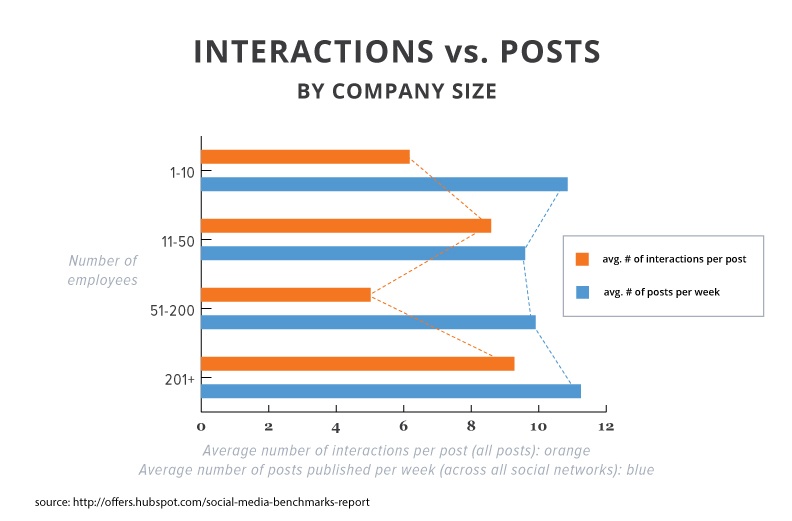Publishing frequency can have almost as big of an impact on your inbound metrics as content quality. Getting the right schedule down is critical to building an audience, winning leads, and closing customers.
Most marketers know that experimentation is the best way to determine optimal publishing frequency for their company. However, experimentation isn't always realistic for companies who are just starting content marketing. If you have less than 10,000 visitors a month or a shoestring content marketing budget, you need to start somewhere. Right?
The Best Blog Publishing Frequency
If you are hoping to maximize your content marketing budget from day one, we've compiled some research on optimal publishing frequency. The best marketers use industry data to shape their strategy, and continually iterate their approach to improve.
In this blog, you'll learn the optimal frequency for publishing blogs, sending emails, publishing offers, and scheduling social media posts. You will also learn some insight on how to develop a data-driven approach, and how to use your metrics to improve your publishing schedule
Blogs
Experts typically recommend that bloggers post between 1-7 posts per week. It can be extremely difficult to build an audience if you're publishing less than once weekly, particularly if your posts are published at irregular intervals. HubSpot's research indicates that the more often you blog, the more leads you'll acquire:

image source: HubSpot
However, blogging 7-15 times each week isn't realistic for many brands. It might not even be optimal for others. Factors that can affect optimal frequency of posting for your company can include:
- Your Buyer Personas
- Budget and Talent
- Your Bandwidth for Great Content Production
- Promotion Budget and Strategy
- SEO Climate & Competition
For most brands, the right publishing frequency is "as often as you can produce exceptionally great blogs." Ultimately, it's better to post two well thought-out, original blogs each week than five mediocre pieces of content. Never sacrifice quality for quantity!
Lead Nurturing Emails
Studies show that letting a week pass without contacting a lead can significantly reduce responsiveness. Research indicates that every four days tends to be the sweet spot for lead communication.
However, this certainly isn't a law. Much like blogging, there are a number of factors that can impact how often you should be communicating with your leads via email:
- The length of your buyer's journey
- The amount of research required to make a purchase
- A lead's status (highly-engaged, disengaged)
- A lead's potential qualification
If your buyer's journey tends to drag on for months, emailing your leads twice per week could be overkill. For brands with a relatively low price point and short buyer's journey, emailing daily could be perfectly appropriate. If you're unsure, selecting the middle ground of emailing every four days may be the right place to start.
Offers
When it comes to offers publishing frequency, the data is pretty simple. The more landing pages the more leads you'll generate. Your chances of publishing too many offers are pretty slim, especially if you're not blasting out mass communications to your entire email contact list every time you create a new eBook or webinar.
It's unlikely that your prospects will get annoyed by a robust library of resources on your businesses' website. Unlike other forms of inbound marketing content, there doesn't appear to be an upper limit for offer generation frequency. Ultimately, you should strive to produce as many offers as you can afford to create, as long as each offer you generate provides some serious value. Repurposing and refocusing your existing content resources is a smart way to appeal to secondary buyer personas while pumping up the volume of your resources library.
Social Media Posts
Social media post frequency can be among the most challenging metrics to establish. Optimal post frequency can vary significantly by the network, audience, and industry. HubSpot's research has found that the median number of posts varies significantly according to industry:

image source: HubSpot
However, your company's size and posts per week can also have a significant impact on your potential for social media engagement:

image source: HubSpot
Brands that post approximately twice a day, seven days a week, tend to have slightly higher-than-average engagement on Facebook. However, Tweeting 1-4 times each hour can yield the best results for Twitter users.
It's important for business social media users to understand the relative life cycles of a post on each social media metric, and how this can affect their potential to gain notice. The lifecycle of a post on Facebook, LinkedIn, and Google+ is much longer than a Tweet. Adjusting your social posting schedule to each network is critical to strike the balance between informative and annoying.
How to Know for Sure
Now that you've gained a baseline knowledge of industry data on how often to post, it's important to shift towards finding the frequency that works for your audience. Marketing experiments often yield surprising results, largely because humans are relatively unpredictable creatures.
In one publishing frequency case study by CoSchedule, the brand found that publishing blogs more often lead to a decrease in engagement. However, this wasn't a perfectly-executed experiment, by their own admission. The brand concluded the experiment with the understanding that changes in authors, topics, publishing time, and promotion methods could have skewed results.
To run experimentation on your own social, blog, email, and offer publishing frequency, here is a process to follow for results you can trust.
- Test Until You're Confident
Statistical significance is the concept of collecting enough data to eliminate risks of errors. Running a publishing frequency experiment for a single week probably won't reveal results you can trust. Test until you're certain, but not a moment longer. The concept of "failing quickly" means you should move on quickly once you've learned that a change in publishing frequency has improved or worsened your results.
2. Support Your Metrics
Has your boss asked you to generate 30 new leads this month? Or 20,000 website visitors? Using your brand's historical metrics to determine your average number of new leads per offer or visitors per blog post can be a powerful tool to plan the right publishing schedule.
3. Increase Volume Slowly
Say you're blogging once a week, and believe that blogging seven times weekly would bring you closer to your goals. Suddenly multiplying your blogging volume by seven can put an enormous burden on your marketing team, especially if you don't have freelance writers or an inbound agency to help out.
Could making the jump in publishing volume overnight quickly improve your metrics faster? Possibly, but it certainly won't help if you burn out your marketing team or experience a drastic drop in content quality along the way.
4. Consider Days and Times
The volume of social media posts is only one factor to consider when it comes to metrics. The days and times you post can also have an impact on the performance of your social media posts, blogs, content offers, and emails.
Chances are, your buyers spend the most time engaging with content during business hours on weekdays. This is probably especially true if they're in the B2B sector. However, the only way to be sure is to test. By measuring content performance on various days of the week and times of day, you can determine when your buyer personas are most likely to consume and share content.
5. Ignore Vanity Metrics
There's an abundance of inbound marketing metrics you can measure as you experiment with optimal publishing frequency. Website visitors, leads, customers, social media followers, email opens, and email subscribers are just a small sampling of the behaviors you can measure using a tool like HubSpot or Google Analytics.
However, it's important to focus on what matters. Keep track your marketing team's key performance indicators (KPIs), and avoid getting too lost in metrics that don't contribute to your bottom line, such as Twitter followers or Pinterest repins.
To learn more about the difference between vanity metrics and KPIs, check out 5 Ways to Measure the Impact of Your Content Marketing.
6. Don't Lose Sight of Quality
Regardless of your plan for marketing experimentation, avoid letting your quality slip. Dramatically increasing your posting frequency isn't easy. You may need to hire additional writers or an agency to help with a newfound volume of work. However, one thing is abundantly clear. You almost certainly won't see better results if you stop writing 2,000-word blogs and switch to 400-word posts. Never sacrifice quality for volume. Your audience is sure to notice.
Finding the Right Volume
If your brand is struggling to build an audience and win customers, the frequency at which you deliver content could be to blame. Increasing the volume of your emails, blogs, offers, and social media posts can increase your exposure and chances of remaining at the top of your consumers' minds. With industry data in mind, the smartest marketers treat their publishing schedules like a continuous marketing experiment.